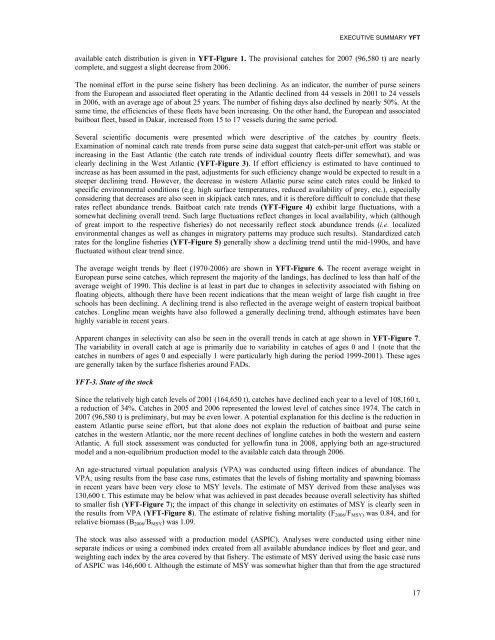REPORT OF THE STANDING COMMITTEE ON RESEARCH ... - Iccat
REPORT OF THE STANDING COMMITTEE ON RESEARCH ... - Iccat
REPORT OF THE STANDING COMMITTEE ON RESEARCH ... - Iccat
You also want an ePaper? Increase the reach of your titles
YUMPU automatically turns print PDFs into web optimized ePapers that Google loves.
EXECUTIVE SUMMARY YFTavailable catch distribution is given in YFT-Figure 1. The provisional catches for 2007 (96,580 t) are nearlycomplete, and suggest a slight decrease from 2006.The nominal effort in the purse seine fishery has been declining. As an indicator, the number of purse seinersfrom the European and associated fleet operating in the Atlantic declined from 44 vessels in 2001 to 24 vesselsin 2006, with an average age of about 25 years. The number of fishing days also declined by nearly 50%. At thesame time, the efficiencies of these fleets have been increasing. On the other hand, the European and associatedbaitboat fleet, based in Dakar, increased from 15 to 17 vessels during the same period.Several scientific documents were presented which were descriptive of the catches by country fleets.Examination of nominal catch rate trends from purse seine data suggest that catch-per-unit effort was stable orincreasing in the East Atlantic (the catch rate trends of individual country fleets differ somewhat), and wasclearly declining in the West Atlantic (YFT-Figure 3). If effort efficiency is estimated to have continued toincrease as has been assumed in the past, adjustments for such efficiency change would be expected to result in asteeper declining trend. However, the decrease in western Atlantic purse seine catch rates could be linked tospecific environmental conditions (e.g. high surface temperatures, reduced availability of prey, etc.), especiallyconsidering that decreases are also seen in skipjack catch rates, and it is therefore difficult to conclude that theserates reflect abundance trends. Baitboat catch rate trends (YFT-Figure 4) exhibit large fluctuations, with asomewhat declining overall trend. Such large fluctuations reflect changes in local availability, which (althoughof great import to the respective fisheries) do not necessarily reflect stock abundance trends (i.e. localizedenvironmental changes as well as changes in migratory patterns may produce such results). Standardized catchrates for the longline fisheries (YFT-Figure 5) generally show a declining trend until the mid-1990s, and havefluctuated without clear trend since.The average weight trends by fleet (1970-2006) are shown in YFT-Figure 6. The recent average weight inEuropean purse seine catches, which represent the majority of the landings, has declined to less than half of theaverage weight of 1990. This decline is at least in part due to changes in selectivity associated with fishing onfloating objects, although there have been recent indications that the mean weight of large fish caught in freeschools has been declining. A declining trend is also reflected in the average weight of eastern tropical baitboatcatches. Longline mean weights have also followed a generally declining trend, although estimates have beenhighly variable in recent years.Apparent changes in selectivity can also be seen in the overall trends in catch at age shown in YFT-Figure 7.The variability in overall catch at age is primarily due to variability in catches of ages 0 and 1 (note that thecatches in numbers of ages 0 and especially 1 were particularly high during the period 1999-2001). These agesare generally taken by the surface fisheries around FADs.YFT-3. State of the stockSince the relatively high catch levels of 2001 (164,650 t), catches have declined each year to a level of 108,160 t,a reduction of 34%. Catches in 2005 and 2006 represented the lowest level of catches since 1974. The catch in2007 (96,580 t) is preliminary, but may be even lower. A potential explanation for this decline is the reduction ineastern Atlantic purse seine effort, but that alone does not explain the reduction of baitboat and purse seinecatches in the western Atlantic, nor the more recent declines of longline catches in both the western and easternAtlantic. A full stock assessment was conducted for yellowfin tuna in 2008, applying both an age-structuredmodel and a non-equilibrium production model to the available catch data through 2006.An age-structured virtual population analysis (VPA) was conducted using fifteen indices of abundance. TheVPA, using results from the base case runs, estimates that the levels of fishing mortality and spawning biomassin recent years have been very close to MSY levels. The estimate of MSY derived from these analyses was130,600 t. This estimate may be below what was achieved in past decades because overall selectivity has shiftedto smaller fish (YFT-Figure 7); the impact of this change in selectivity on estimates of MSY is clearly seen inthe results from VPA (YFT-Figure 8). The estimate of relative fishing mortality (F 2006 /F MSY) was 0.84, and forrelative biomass (B 2006 /B MSY ) was 1.09.The stock was also assessed with a production model (ASPIC). Analyses were conducted using either nineseparate indices or using a combined index created from all available abundance indices by fleet and gear, andweighting each index by the area covered by that fishery. The estimate of MSY derived using the basic case runsof ASPIC was 146,600 t. Although the estimate of MSY was somewhat higher than that from the age structured17
















